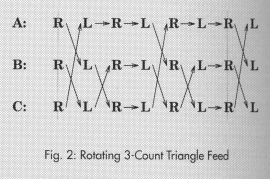|
Rotating
Three Count Triangle Feed Rob
Street of York, England, submitted this pattern to the network
newsgroup rec.juggling this Spring and it reminded me of the Supernova
that I described last time, though this one has nine clubs and the
Supernova has 10. Both are triangle patterns with two people doing
pass-pass-self, although the 10-club Supernova has the third person
passing more often than in this nine-club triangle. If you have
trouble with the Supernova, try this easier pattern, which,
nevertheless, is "Ah, another lovely pattern to get the grey
matter working," according to Rob.
In
this pattern, whose causal diagram is shown in Fig. 2, juggler A does
a three-count, always passing to B and always receiving from C. (I
call this type of pass a "triangle pass," because all three
people are passing at the same and everyone is passing to one person
but receiving from another. There are no exchanges of clubs between
any two people in a triangle pass.) It is the easiest role in the
pattern.
Each
of jugglers B and C does pass-pass-self (PPS). But B passes only to C,
whereas C alternates passing to A and B. When C passes to B, it is an
exchange, because B is simultaneously passing to C. But when C passes
to A, it is a triangle pass. So B and C both do the sequence: triangle
pass, exchange, self (and they have to do it in phase, since the
triangle passes have to occur all at the same time by definition).
Rob
suggests that, after you have learned all three roles, to test your
grey matter a bit more, you can change roles dynamically every six
counts. A takes on B's original role, while B takes C's and C takes A's.
Keep rotating roles every six counts and everyone will have the same
degree of difficulty overall, although each of you gets a brief
respite now and then during
Here's
another variation you can try. If you look at Fig. 2, you'll notice
that all three jugglers have selves at the same time (on counts three
and six). So if you want to spice up the pattern, you can turn some or
all of those selves into passes. E.g., you could have A and B do an
exchange, or you could add another triangle pass, perhaps by reversing
the |
